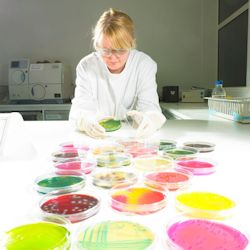The Challenge of Det...
How To Set a Microbi...
31st January 2017 Content supplied by: Campden BRI
Shiga Toxin Producing Escherichia coli (STEC) in Food

Article by Dr Roy Betts, Head of Microbiology, Campden BRI
Shiga Toxin producing E.coli (STEC) and Veroctyotoxin producing E.coli (VTEC) are two names for exactly the same group of microorganisms. In the USA this group of very pathogenic organisms are known as STEC, whilst in Europe they tended to be referred to as VTEC. We often see both names used in publications.
STEC are a group of pathogenic E.coli that contain genes coding for “shiga toxin” (stx). Shiga toxin can also be known as Verocytotoxin or (VT). The most well know of this group is E.coli O157, however many hundreds of STEC serogroups exist and all have the potential to cause human illness.
If STEC are consumed within a food and reach the gut they will begin to multiply. They attach to the gut wall with the aid of a series of proteins encoded by genes from the Locus of Enterocyte Effacement (LEE). This gene series, which includes the eae gene, are present on the E.coli chromosome. Attachment to the gut can cause the first primary symptom of severe STEC infection - haemorrhagic colitis or severe bloody diarrhoea. The organism can also produce shiga toxin, which enters the bloodstream and can cause kidney damage, leading to haemolytic uremic syndrome (HUS). The severe symptoms caused by STEC can often result in hospitalisation and, in the worst cases, those affected can die.
The infective dose for STEC is known to be very low. It’s believed that ingestion of as few as 10 cells can cause illness. Due to the low infective dose and nature of the symptoms, person-to-person spread is likely unless great care is taken with personal hygiene.
Non-O157 STEC Organisms Initially, E.coli O157 was the only organism that was considered to be an issue within the STEC group. While E.coli O157 is the cause of most STEC related illnesses in many countries, a wide range of other serogroups have caused serious outbreaks. This has resulted in a range of measures being implemented in various countries to test for and prevent the sale of contaminated products. In the USA, there is a legal requirement to test various domestically produced or imported beef cuts for STEC serogroups O26, O45, O103, O111, O121 and O157, as it has been recognised that all of these have caused or have the potential to cause serious illness. EU manufacturers of sprouted seeds have a legal requirement to test seeds or seed irrigation water for STEC serogroups O157, O26, O103, O111, O145 and O104:H4. Any samples that test positive are not allowed to market.
Draft EU guidance which has been carried forward in draft form by the UK by the Food Standards Agency (FSA) suggests that any ready to eat food is unfit to eat if it has been contaminated with an organism from any STEC serogroup. We need to be aware of the food safety risks posed by any member of the STEC group.
Implicated Foods When STEC infections were first widely recognised in the late 1980s E.coli O157 was the sole serogroup of concern and this was primarily linked to improperly cooked comminuted beef products, such as burgers. Since then O157 has also been linked with a variety of dairy products including milk and cheeses made from both cow’s and goat’s milk. Fresh produce has also been identified to be a cause of E.coli O157 outbreaks, with spinach, lettuce, watercress, apples, nuts and sprouted seeds being linked with the organism. All of these routes of infection originate from the primary animal source. E.coli is generally an organism that colonises the animal gut. Raw meats can become contaminated through poor abattoir hygiene if faecal material comes into contact with prepared carcasses; dairy products can be contaminated through poor dairy hygiene during milking; and fresh produce can be exposed to STEC organisms via contaminated irrigation water, water run off from animal grazed fields, or simply wild animals traversing crop fields.
Poor hygiene during food preparation which brings raw foods in direct or indirect contact with ready to eat foods, such as cooked sliced meats, has also resulted in outbreaks.
Controls Measures STEC are not difficult to control. They are not heat resistant and a standard centre cooking temperature of 70°C for 2 minute process (or equivalent) will give a substantial 6 log reduction. They are no more resistant to sanitisers that other enteric pathogens and their growth will be considerably inhibited by good chilled temperatures. It is difficult to determine if the group are any more acid resistant that non-STEC E.coli, however numerous publications have indicated that various strains of STEC can survive at pH 4, and food with pHs as low as 3.6 have been implicated in outbreaks. Generally low pH cannot be used as a measure to inactivate STEC without validation. Contamination of fresh produce by STEC is controlled by hygienic growth/harvesting and careful use of irrigation waters.
Cross contamination can be controlled using simple hygiene measures. Most outbreaks that have been traced to cross contamination have been caused by a breakdown in simple hygiene control. The UK FSA’s guidance on the control of O157 recommends simple hygienic measures that will minimise risks of cross contamination between raw meats and ready to eat foods.
Testing and What do the Results Mean? In Europe STEC can only be handled within a Category 3 pathogen laboratory, which makes validation of methods difficult for many laboratories. ISO Technical Specification 13136 details a method for the detection of STEC from foods and a range of proprietary kits are available for laboratories to use. While laboratories -including Campden BRI - are accredited to ISO 17025 to do this testing, the key challenge is not the test itself, but the interpretation of the results. The test does not gives a simple yes/no answer. What is does is show is the presence of stx genes, eae genes and determine the presence of one of the top 6 serogroups. But how are these various results interpreted and food safety decisions made? What happens if one of the top serogroups is detected, but it contains no stx genes? While this result suggests the organism is not an STEC, it doesn’t tell you if it is a risk to consumers. This is just one example of the interpretational difficulties faced by those doing STEC testing. In those situations it is prudent to engage expert food microbiological assistance to help in decision making.
The Future Campden BRI will be running a seminar on STEC considering current issues and future needs on 12th May 2017. For further information please contact Roy Betts

About the author: As Head of Microbiology at Campden BRI, Dr. Roy Betts currently manages a large team of scientists and technicians and is a recognised expert in food microbiology. Roy has recently led the establishment and UKAS accreditation of Campden BRI's category 3 laboratory for STEC testing.
Date Published: 31st January 2017
Source article link: View
Related news
The Challenge of Detecting Foodborne
How To Set a Microbiological

